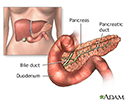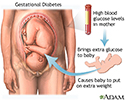Gestational diabetes
Glucose intolerance during pregnancy
Gestational diabetes is high blood sugar ( diabetes ) that starts or is first diagnosed during pregnancy.
Diabetes
Diabetes is a chronic disease in which the body cannot regulate the amount of sugar in the blood.

Causes
Pregnancy hormones can block insulin from doing its job. When this happens, glucose level may increase in a pregnant woman's blood.
You are at greater risk for gestational diabetes if you:
- Are older than 25 when you are pregnant
- Come from a higher risk ethnic group, such as Hispanic American, African American, Native American, Southeast Asian, or Pacific Islander
- Have a family history of diabetes
- Gave birth to a baby that weighed more than 9 pounds (4 kg) or had a birth defect
-
Have
high blood pressure
High blood pressure
Blood pressure is a measurement of the force exerted against the walls of your arteries as your heart pumps blood to your body. Hypertension is the ...
 ImageRead Article Now Book Mark Article
ImageRead Article Now Book Mark Article - Have too much amniotic fluid
- Have had an unexplained miscarriage or stillbirth
- Were overweight before your pregnancy
- Gain too much weight during your pregnancy
- Have polycystic ovarian syndrome
Symptoms
Most of the time there are no symptoms. The diagnosis is made during a routine prenatal screening.
Mild symptoms, such as increased thirst or shakiness, may be present. These symptoms are usually not life threatening to the pregnant woman.
Other symptoms may include:
-
Blurred vision
Blurred vision
There are many types of eye problems and vision disturbances, such as: HalosBlurred vision (the loss of sharpness of vision and the inability to see ...
 ImageRead Article Now Book Mark Article
ImageRead Article Now Book Mark Article -
Fatigue
Fatigue
Fatigue is a feeling of weariness, tiredness, or lack of energy.
Read Article Now Book Mark Article - Frequent infections, including those of the bladder, vagina, and skin
-
Increased thirst
Increased thirst
Excessive thirst is an abnormal feeling of always needing to drink fluids.
 ImageRead Article Now Book Mark Article
ImageRead Article Now Book Mark Article - Increased urination
Exams and Tests
Gestational diabetes most often starts halfway through the pregnancy. All pregnant women should receive an oral glucose tolerance test between the 24th and 28th week of pregnancy to look for the condition. Women who have risk factors for gestational diabetes may have this test earlier in the pregnancy.
Oral glucose tolerance test
A glucose screening test is a routine test during pregnancy that checks a pregnant woman's blood glucose (sugar) level. Gestational diabetes is hi...
Once you are diagnosed with gestational diabetes, you can see how well you are doing by testing your glucose level at home. The most common way involves pricking your finger and putting a drop of your blood on a machine that will give you a glucose reading.
Treatment
The goals of treatment are to keep blood sugar (glucose) level within normal limits during the pregnancy, and to make sure that the growing baby is healthy.
WATCHING YOUR BABY
Your health care provider should closely check both you and your baby throughout the pregnancy. Fetal monitoring will check the size and health of the fetus.
A nonstress test is a very simple, painless test for you and your baby.
Nonstress test
Prenatal care - monitoring; Pregnancy care - monitoring; Non-stress test - monitoring; NST- monitoring; Contraction stress test - monitoring; CST- mo...
- A machine that hears and displays your baby's heartbeat (electronic fetal monitor) is placed on your abdomen.
- Your provider can compare the pattern of your baby's heartbeat to movements and find out whether the baby is doing well.
DIET AND EXERCISE
The best way to improve your diet is by eating a variety of healthy foods. You should learn how to read food labels, and check them when making food decisions. Talk to your provider if you are a vegetarian or on another special diet.
In general, when you have gestational diabetes your diet should:
When you have gestational diabetes
Gestational diabetes is high blood sugar (glucose) that starts during pregnancy. Eating a balanced, healthy diet can help you manage gestational dia...
- Be moderate in fat and protein
- Provide your carbohydrates through foods that include fruits, vegetables, and complex carbohydrates (such as bread, cereal, pasta, and rice)
- Be low in foods that contain a lot of sugar, such as soft drinks, fruit juices, and pastries
If managing your diet does not control blood sugar (glucose) level, you may be prescribed diabetes medicine by mouth or insulin therapy.
Most women who develop gestational diabetes will not need diabetes medicines or insulin, but some will.
Outlook (Prognosis)
There are many risks of having diabetes in pregnancy when blood sugar is not well controlled. With good control, most pregnancies have good outcomes.
Pregnant women with gestational diabetes tend to have larger babies at birth. This can increase the chance of problems at the time of delivery, including:
- Birth injury (trauma) because of the baby's large size
-
Delivery by
C-section
C-section
A C-section is the delivery of a baby through a surgical opening in the mother's lower belly area. It is also called a cesarean delivery.
 ImageRead Article Now Book Mark Article
ImageRead Article Now Book Mark Article
Your baby is more likely to have periods of low blood sugar ( hypoglycemia ) during the first few days of life.
Hypoglycemia
Low blood sugar is a condition that occurs when the body's blood sugar (glucose) decreases and is too low. Blood sugar below 70 mg/dL (3. 9 mmol/L) i...

Mothers with gestational diabetes have an increased risk for high blood pressure during pregnancy .
High blood pressure during pregnancy
Preeclampsia is when a pregnant woman develops high blood pressure and protein in the urine after the 20th week of pregnancy.

After delivery:
- Your high blood sugar (glucose) level often goes back to normal.
- You should be closely followed for signs of diabetes over the next 5 to 10 years after delivery.
When to Contact a Medical Professional
Call your provider if you are pregnant and you have symptoms of diabetes .
Diabetes
Diabetes is a chronic disease in which the body cannot regulate the amount of sugar in the blood.

Prevention
Getting prenatal care early and having regular checkups helps improve your health and the health of your baby. Having prenatal screening at 24 to 28 weeks of pregnancy will help detect gestational diabetes early.
If you are overweight, getting your weight within the normal body mass index (BMI) range will decrease your risk of gestational diabetes.
Body mass index
A good way to decide if your weight is healthy for your height is to figure out your body mass index (BMI). You and your health care provider can us...

References
American Diabetes Association. Standards of medical care in diabetes—2016. Diabetes Care . 2016;39(suppl 1):S1-S106.
Landon MB, Catalano PM, Gabbe SG. Diabetes mellitus complicating pregnancy. In: Gabbe SG, Niebyl JR, Simpson JL, et al, eds. Obstetrics: Normal and Problem Pregnancies . 7th ed. Philadelphia, PA: Elsevier Saunders; 2017:chap 40.
Metzger BE. Diabetes mellitus and pregnancy. In: Jameson JL, De Groot LJ, de Kretser DM, et al, eds. Endocrinology: Adult and Pediatric . 7th ed. Philadelphia, PA: Elsevier Saunders; 2016:chap 45.
Moyer VA. Screening for gestational diabetes mellitus: U.S. Preventive Services Task Force recommendation statement. Ann Intern Med . 2014;160:414-420. PMID: 24424622 www.ncbi.nlm.nih.gov/pubmed/24424622 .
-
Pancreas - illustration
The pancreas is located behind the liver and is where the hormone insulin is produced. Insulin is used by the body to store and utilize glucose.
Pancreas
illustration
-
Gestational Diabetes - illustration
Gestational diabetes is defined as glucose intolerance during pregnancy. During your pregnancy, hormonal changes can cause the body to be less sensitive to the effect of insulin. These changes can lead to high blood sugar and diabetes. High blood sugar levels in pregnancy are dangerous for both mother and baby.
Gestational Diabetes
illustration
-
Pancreas - illustration
The pancreas is located behind the liver and is where the hormone insulin is produced. Insulin is used by the body to store and utilize glucose.
Pancreas
illustration
-
Gestational Diabetes - illustration
Gestational diabetes is defined as glucose intolerance during pregnancy. During your pregnancy, hormonal changes can cause the body to be less sensitive to the effect of insulin. These changes can lead to high blood sugar and diabetes. High blood sugar levels in pregnancy are dangerous for both mother and baby.
Gestational Diabetes
illustration
Review Date: 5/16/2016
Reviewed By: Irina Burd, MD, PhD, Associate Professor of Gynecology and Obstetrics at Johns Hopkins University School of Medicine, Baltimore, MD. Review provided by VeriMed Healthcare Network. Also reviewed by David Zieve, MD, MHA, Isla Ogilvie, PhD, and the A.D.A.M. Editorial team.


